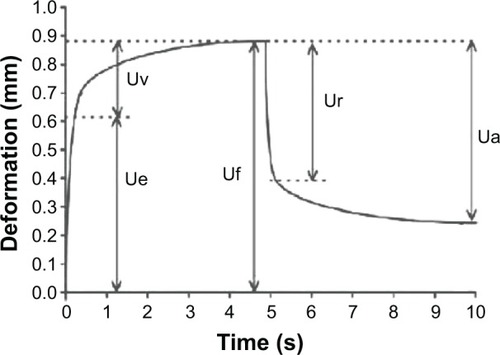Abstract
Background
During menopause, the decrease of estrogenic secretion induces the disruption of skin functioning, thus causing the decline in skin elasticity characteristic of skin aging. The purpose of this study was to evaluate in postmenopausal women the effect of daily consumption and/or application of argan oil on skin elasticity.
Materials and methods
Sixty postmenopausal women consumed butter during the stabilization period and were randomly divided into two groups for the intervention period: the treatment group of 30 participants received dietary argan oil, the control group of 30 participants received olive oil, and both groups applied cosmetic argan oil in the left volar forearm during a 60-day period. Assessments of skin elasticity parameters, ie, the three R-parameters (R2 or gross-elasticity of the skin, R5 or net elasticity of the skin, and R7 or biological elasticity), and the resonance running time (RRT) at both volar forearms of the two groups were performed during three visits: before starting oils consumption and application, after 30 days of oils consumption and application, and after 60 days of oils consumption and application.
Results
The consumption of argan oil led to a significant increase of gross-elasticity of the skin (R2) (P<0.001), net elasticity of the skin (R5) (P<0.001), biological elasticity (R7) (P<0.001), and a significant decrease of RRT (P=0.002). The application of argan oil led to a significant increase of gross-elasticity of the skin (R2) (P<0.001), net elasticity of the skin (R5) (P<0.001), biological elasticity (R7) (P=0.001), and a significant decrease of RRT (P<0.001).
Conclusion
Our findings suggest that the daily consumption and/or topical application of argan oil have an anti-aging effect on the skin demonstrated by the improvement of skin elasticity, characterized by an increase of R-parameters (R2, R5, and R7) and a decrease of RRT.
Introduction
The skin is stratified into two essential superposed layers: the outermost layer or epidermis and the deeper layer or dermis.
The dermis provides a solid support for the epidermis. It is also its feeder layer. It consists mainly of fibroblasts, cells responsible for collagen and elastic fibers synthesis that enter into the extracellular matrix composition.Citation1
Elastic fibers are closely linked and interwoven with the collagen fibrils so that they can recoil after transient stretching, preventing overstretching.
The presence of collagen and elastic fibers or the major (97.5%) and the minor (2.5%) compounds of dermis, respectively, promote the maintenance of resilience and elastic appearance of the skin.Citation2
The decrease of estrogenic secretion observed during menopause negatively affects the skin elasticity by a decrease of dermal fibroblasts collagenCitation3 and elastic fibers,Citation4 characteristic of skin aging;Citation5 this is the main reason we chose healthy postmenopausal women as the test population for this study.
Treatment with estrogen reverses the changes of collagen and elastic fibers,Citation6,Citation7 which favor the improvement of skin elasticity in postmenopausal women.Citation8 But the long-term use of estrogen in the form of hormone replacement therapy triggers many pathophysiological events.Citation9
The consumption of dietary argan oil has proved to have a positive effect in the prevention of certain diseases (high cholesterol,Citation10 heart disease,Citation11 diabetes,Citation12 etc) that are known to have a high incidence in postmenopausal womenCitation13 and which may thus be beneficial in treating reduced skin elasticity during menopause.
Although argan oil has a long history in traditional cosmetic use, to maintain the health of skin,Citation14 its effect on skin elasticity has never been scientifically reported. Therefore, we have attempted to elucidate the effect of argan oil on skin elasticity.
The purpose of this study was to evaluate in postmenopausal women the effect of daily consumption and topical application of argan oil on skin elasticity, as measured by the skin’s biomechanical properties that are represented by R-parameters (R2 or gross-elasticity of the skin, R5 or net elasticity of the skin, and R7 or biological elasticity), and resonance running time (RRT) using noninvasive biophysical methods.
Materials and methods
Participants
One hundred postmenopausal women were recruited in our study; 60 of them met the following criteria:
Inclusion criteria: menopause confirmed by dosages of estradiol and follicle-stimulating hormone (estradiol <30 pg/mL and follicle-stimulating hormone >40 IU/L) and absence of skin diseases.
Exclusion criteria: taking a hormone replacement therapy, and use of moisturizing and anti-aging products and dietary supplements.
The 60 postmenopausal women selected gave their informed consent and the study was approved by the Ethical Committee for Biomedical Research of the Faculty of Medicine and Pharmacy, University Mohammed V Rabat, Morocco.
Products
The following products were used in this study: butter, olive oil of the Moroccan Picholine, and dietary and cosmetic argan oil provided by the cooperative Targante with the ECOCERT label.
Study protocol
In this study, there were two diet periods (). In diet period 1 (baseline diet), all of the participants consumed 25 g/day of the same brand of butter for 2 weeks to stabilize the lipid profile.Citation15 In diet period 2, the 60 participants were randomly assigned to the two following diet groups using the “Data – Select cases – Random sample of cases” procedure in SPSS (version 10, IBM Corporation, Armonk, NY, USA): one group of 30 participants, in which 25 g/day butter was substituted by 25 mL/day of argan oil, and the second group of 30 participants consuming 25 mL/day of olive oil as a control during a 60-day period. In parallel, the two groups were asked to apply every night about 240 mg (2 mg/cm2) of cosmetic argan oil, corresponding to 10 drops, on the left volar forearm (LF) and were forbidden to use any other skin care or cosmetic products on their volar forearms throughout the study.
Figure 1 Overall protocol of the study.
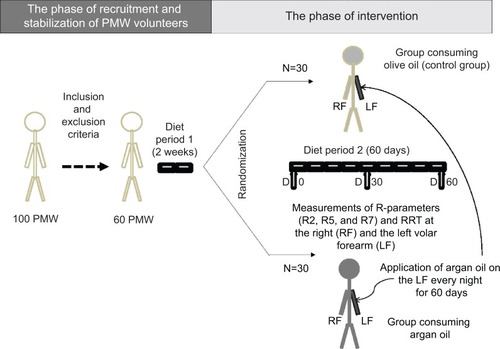
Cosmetic argan oil and alimentary argan and olive oil bottles were delivered to participants every 30 days by the research staff, in order to meet the participants and ensure their adherence to the study. The residual alimentary and cosmetic oil bottles were collected at the time of the next delivery in order to check the adherence of the participants to the allocated treatment. Olive oil was deliberately chosen as the oil of the control group to ensure adherence to the study of women not receiving argan oil, as olive oil is also considered an oil with noble nutritional virtues and widely known for its beneficial health effects.
In the two groups, assessments of skin elasticity, ie, the R-parameters (R2, R5, and R7), and the RRT at the right volar forearm (RF) and the LF were performed in the morning during three visits: before starting oil consumption and application (D0), after 30 days of oil consumption and application (D30), and after 60 days of oil consumption and application (D60).
Bioengineering methods
The measurements of skin elasticity were performed with a Cutometer SEM 575® and a Reviscometer RVM 600®, which were mounted on a Multi Probe Adapter® MPA5 (Courage and Khazaka Electronic GmbH, Cologne, Germany).
The Cutometer SEM 575 with a 2 mm diameter probe is an electronic instrument that assesses biomechanical properties of the skin based on the suction and elongation measuring principle. The time/strain mode (mode 1) was used with ten consecutive cycles of a 2-second application of a constant negative pressure of 450 mbar, followed by a 2-second relaxation period.
A typical skin deformation curve is illustrated in and the following parameters were analyzed: (R2) Ua (the ability of redeformation of skin)/Uf (final distension [skin distensibility]), gross-elasticity of the skin, including viscous deformation;Citation16 (R5) Ur (immediate retraction)/Ue (immediate distension), net elasticity of the skin without viscous deformation;Citation16 (R7) Ur/Uf, biological elasticity, ie the ratio of immediate retraction to final distension.Citation16 The Reviscometer RVM 600 also allows for the evaluation of the mechanical properties of skin by measuring the propagation time of a shear wave between two sensors placed on the skin surface: one is transmitting an acoustical shockwave, and the other is the receiver. The time the wave needs to propagate from transmitter to recipient is the measured parameter that is defined as RRT. It has been shown that RRT is inversely related to skin elasticity.Citation17 The longer the time the waves need to propagate through the material, the higher the measuring value and the less elastic the material. We measured RRT according to manufacturer instructions.
Statistical analysis
All values are expressed as mean ± standard deviation (SD). R-parameters (R2, R5, and R7), RRT values, and other variables were normally distributed as assessed by the Kolmogorov–Smirnov test.
The parametric test, analysis of variance (ANOVA) for repeated measures, was applied for comparisons of the three paired means (± SD) of R2, R5, R7, and RRT (taken at D0, D30, and D60) of the two volar forearms (RF and LF) of each group (argan and olive). When the ANOVA test for repeated measures was significant, the Bonferroni test was applied to perform post hoc pairwise multiple comparisons within the three paired means (± SD) of R2, R5, R7, and RRT.
The Student’s t-test for independent samples was used to compare the mean of the R2, R5, R7, and RRT between the two forearms of each group at the beginning of the study (at D0) to prove the homogeneity of the results and at the end of the study (at D60) to support the results of the ANOVA for repeated measures.
Differences were considered to be statistically significant at P<0.05 and the statistical software SPSS version 10.0 was used.
Results
Baseline demographic and clinical characteristics of participants treated with argan and olive oil in both groups are shown in .
Table 1 Baseline demographic and clinical characteristics of the argan and olive groups
Results of the untreated forearm or RF
In the group consuming argan oil, the paired means (± SD) of R-parameters (R2, R5, and R7) and RRT values as a function of time (D0, D30, and D60) showed a statistically significant difference (at the P<0.05 level) between at least two means (± SDs) of R-parameters (, , and ) and RRT () with a level of significance of P<0.001 and P=0.002, respectively. This statistically significant difference existed between the D0 and the D60 mean (± SD) for R2 (P=0.001; ), R5 (P<0.001; ), R7 (P<0.001; ), and RRT (P=0.002; ) and between the D30 and the D60 mean (± SD) for R2 (P=0.019; ), R5 (P=0.006; ), R7 (P=0.011; ), and RRT (P=0.001; ). No statistically significant difference was observed between at least two means (± SDs) of R-parameters (P>0.05; , , and ) and RRT values (P>0.05; ) in the group consuming olive oil.
Figure 3 Volar forearm R2 (gross-elasticity of the skin) evolution.
Notes: Evolution after oils consumption and/or argan oil application at (A) the RF in the group consuming argan oil, (B) the RF in the group consuming olive oil, (C) the LF in the group consuming argan oil, and (D) the LF in the group consuming olive oil. The difference between the three paired means (± SD) of R2 (taken at D0, D30, and D60) of the two volar forearms (RF and LF) of each group (argan and olive) was analyzed using the ANOVA test for repeated measures followed by the Bonferroni post hoc test (if the ANOVA test for repeated measures was statistically significant). P<0.05 was considered statistically significant (for the results of the ANOVA test for repeated measures). NS: ANOVA test for repeated measures showed no statistically significant difference (P>0.05). *P<0.05 was considered statistically significant (for the results of the Bonferroni post hoc test).
Abbreviations: ANOVA, analysis of variance; D0, before starting oil consumption and application; D30, after 30 days of oil consumption and application; D60, after 60 days of oil consumption and application; LF, left volar forearm; NS, no significant difference; RF, right volar forearm; SD, standard deviation; Ua/Uf, gross-elasticity of the skin, including viscous deformation.
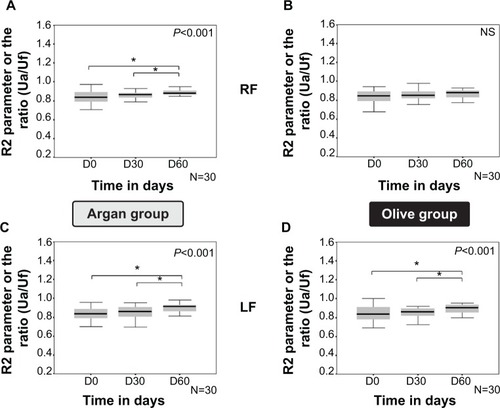
Figure 4 Volar forearm R5 (net elasticity of the skin without viscous deformation) evolution.
Notes: Evolution after oils consumption and/or argan oil application at (A) the RF in the group consuming argan oil, (B) the RF in the group consuming olive oil, (C) the LF in the group consuming argan oil, and (D) the LF in the group consuming olive oil. The difference between the three paired means (± SD) of R5 (taken at D0, D30, and D60) of the two volar forearms (RF and LF) of each group (argan and olive) was analyzed using the ANOVA test for repeated measures followed by the Bonferroni post hoc test (if the ANOVA test for repeated measures was statistically significant). P<0.05 was considered statistically significant (for the results of the ANOVA test for repeated measures). NS: the ANOVA test for repeated measures showed no statistically significant difference (P>0.05). *P<0.05 was considered statistically significant (for the results of the Bonferroni post hoc test).
Abbreviations: ANOVA, analysis of variance; D0, before starting oil consumption and application; D30, after 30 days of oil consumption and application; D60, after 60 days of oil consumption and application; LF, left volar forearm; NS, no significant difference; RF, right volar forearm; SD, standard deviation; Ur/Ue, net elasticity of the skin without viscous deformation.
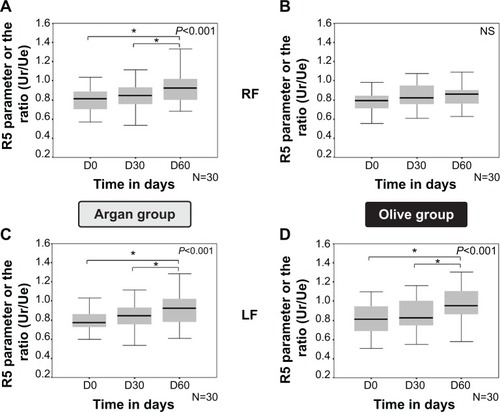
Figure 5 Volar forearm R7 (biological elasticity) evolution.
Notes: Evolution after oils consumption and/or argan oil application at (A) the RF in the group consuming argan oil, (B) the RF in the group consuming olive oil, (C) the LF in the group consuming argan oil, and (D) the LF in the group consuming olive oil. The difference between the three paired means (± SD) of R7 (taken at D0, D30, and D60) of the two volar forearms (RF and LF) of each group (argan and olive) was analyzed using the ANOVA test for repeated measures followed by the Bonferroni post hoc test (if the ANOVA test for repeated measures was statistically significant). P<0.05 was considered statistically significant (for the results of the ANOVA test for repeated measures). NS: the ANOVA test for repeated measures showed no statistically significant difference (P>0.05). *P<0.05 was considered statistically significant (for the results of the Bonferroni post hoc test).
Abbreviations: ANOVA, analysis of variance; D0, before starting oil consumption and application; D30, after 30 days of oil consumption and application; D60, after 60 days of oil consumption and application; LF, left volar forearm; NS, no significant difference; RF, right volar forearm; SD, standard deviation; Ur/Uf, biological elasticity, ie, the ratio of immediate retraction to final distension.
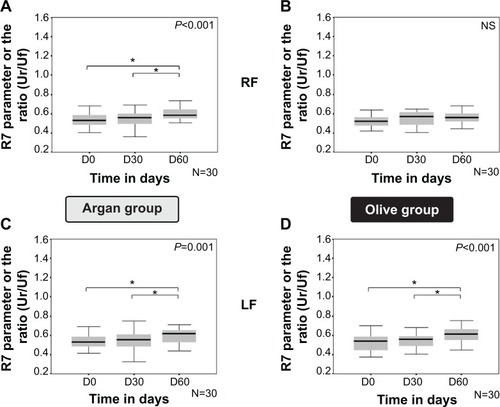
Figure 6 Volar forearm RRT evolution.
Abbreviations: ANOVA, analysis of variance; AU, arbitrary units; D0, before starting oil consumption and application; D30, after 30 days of oil consumption and application; D60, after 60 days of oil consumption and application; LF, left volar forearm; NS, no significant difference; RF, right volar forearm; RRT, resonance running time; SD, standard deviation.
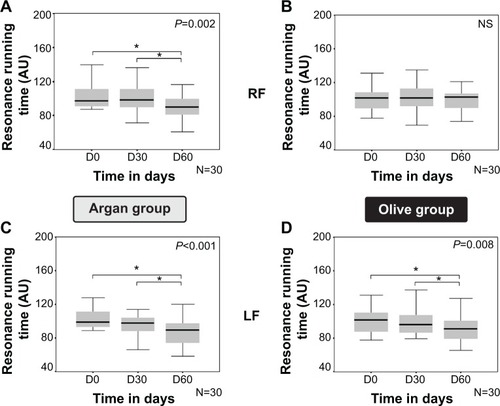
Between the group consuming argan oil and that consuming olive oil, there was no statistically significant difference in the unpaired means (± SD) of the means (± SD) of R-parameters (P>0.05) and RRT (P>0.05) at baseline (D0), but there was a statistically significant difference after the 60-day period (D60) in favor of the group consuming argan oil for the R2 (P=0.036), R5 (P=0.036), R7 (P=0.012), and RRT values (P=0.006) ().
Table 2 The intergroup comparison of R-parameters (R2, R5, and R7) and resonance running time of the volar forearm between the two groups before (D0) and after 60 days (D60) of oils consumption and/or argan oil application
Results of the treated forearm or LF
The paired means (± SD) of R-parameters (R2, R5, and R7) and RRT values as a function of time (D0, D30, and D60) showed a statistically significant difference between at least two means (± SDs) of R2, R5, R7, and RRT with a level of significance of P<0.001, P<0.001, P=0.001 (, , and ), and P<0.001 (), respectively, in the group consuming argan oil, and with a level of significance of P<0.001 (, , ) and P=0.008 (), respectively, in the group consuming olive oil. This statistically significant difference existed between the D0 and the D60 means (± SD) for R2 (P<0.001 in the two groups; ), R5 (P=0.006 in the group consuming argan oil and P<0.001 in the group consuming olive oil; ), R7 (P<0.001 in the two groups; ), and RRT (P<0.001 in the group consuming argan oil and P=0.022 in the group consuming olive oil; ), and between the D30 and the D60 means (± SD) for R2 (P=0.004 in the group consuming argan oil and P=0.002 in the group consuming olive oil; ), R5 (P=0.007 in the group consuming argan oil and P=0.001 in the group consuming olive oil; ), R7 (P=0.010 in the group consuming argan oil and P<0.001 in the group consuming olive oil; ), and RRT (P=0.001 in the group consuming argan oil and P=0.022 in the group consuming olive oil; ).
Between the group consuming argan oil and that consuming olive oil, there was no statistically significant difference in the unpaired means (± SD) of R-parameters (P>0.05) and RRT values (P>0.05) at baseline (D0) and after the 60-day period (D60) ().
Comparison of topical-argan-oil-treated and -untreated forearms, or LF and RF, in the two groups
Between the RF and the LF in the two groups (argan and olive), there was no statistically significant difference in the unpaired means (± SD) of R-parameters (P>0.05) and the RRT (P>0.05) at baseline (D0), but there was a statistically significant difference after the 60-day period (D60) in favor of the LF in the group consuming olive oil with P=0.023, P=0.004, P=0.005, and P=0.022 for the R2, R5, R7, and RRT values, respectively ().
Table 3 The intergroup comparison of R-parameters (R2, R5, and R7) and resonance running time between the two volar forearms (RF and LF) before (D0) and after 60 days (D60) of oils consumption and/or argan oil application in the two groups
Discussion
In this study we have demonstrated that the daily consumption and topical application of argan oil improves skin elasticity by increasing the R-parameters (R2, R5, and R7) and decreasing the RRT in postmenopausal women after a period of 60 days.
In postmenopausal women, the decline in endogenous estrogen levels negatively affects skin elasticity, which causes a loss of skin collagen of up to 30% during the first 5 years after menopauseCitation3,Citation18,Citation19 or an average decline of 2.1% per postmenopausal year over 15 years.Citation18 This also leads to the acceleration of degenerative changes in dermal elastic fibers,Citation4 thus favoring the acceleration of skin aging.
This loss of collagen and elastic fibers may be the result of two mechanisms: the synthesis decrease and the degradation increase of collagen and elastic fibers. The decrease of collagen and elastic fibers synthesis would be due to the influence of hypoestrogenism on the synthesis of transforming growth factor-beta (TGFβ),Citation20 a cytokine involved in the activation of collagen and elastic fibers production via the signaling pathway.Citation21 The increase of collagen and elastic fibers degradation would be due to the increase of reactive oxygen species (ROS) caused by the decrease of estrogen, representing the antioxidant of the human body, which induces an imbalance between the production of ROS and antioxidative defense observed at menopause,Citation22 favoring the activation of matrix metalloproteinases (MMPs),Citation23 a family of zinc-containing proteinases that have the ability to degrade collagen and elastic fibers.Citation24
Estrogen treatment has improved skin elasticity by increasing collagen and elastic fibers synthesis, resulting from a decrease of TGFβ, as well as by decreasing collagen and elastic fibers degradation, resulting from a decrease of MMPs.
This shows that estrogen treatment has a beneficial effect on reversing skin aging signs and maintaining skin elasticity in postmenopausal women,Citation25 but its long-term use in the form of hormone replacement therapy triggers many pathophysiological events.Citation9
The measurements of R-parameters have widely been used for determining biomechanical properties of human skin. The following R-parameters are known indicators of skin elasticity:Citation26 R2 is a measure of the gross elasticity of the skin, including viscous deformation, and is represented by the ratio of “the ability of redeformation of skin” to “final distension,” ie, Ua/Uf,Citation16 or it is also known as the overall elasticity of the skin including creep and creep recovery.Citation27 R5 is the so-called net elasticity of skin without viscous deformation. Elastic recovery is represented by the ratio of “immediate retraction” to “immediate distension,” ie, Ur/Ue.Citation16 R7 is referred to as biological elasticity. This parameter relates elasticity with final distension. It is represented by the ratio of “immediate retraction” to “final distension,” ie, Ur/Uf.Citation16
In addition to the above measurements, skin elasticity measurements were also paralleled and confirmed by the RRT, measurements that represent the propagation time of a shear wave between two sensors placed on the skin surface; it has been shown that RRT is inversely related to skin elasticity.Citation17
In this study, the results of the RF comparison showed an improvement in skin elasticity after 60 days of dietary argan oil consumption, which was demonstrated by a statistically significant increase of R-parameters (R2, R5, and R7), since the closer the values are to 1 (100%), the more elastic the skin is.Citation28 These increased R-parameters (R2, R5, and R7) were related to the increase of the content of collagen and elastic fibers of the skin, which agrees with the study by Ryu et al in which R2, R5, and R7 were negatively correlated to skin aging,Citation29 characterized by the decrease of collagen and elastic fibers. In addition, these results of R-parameters were also confirmed by the statistically significant decrease of RRT, since the higher the measuring value, the less elastic the skin is,Citation30 while no statistically significant improvement in skin elasticity was provided after the consumption of olive oil. As well, the comparison of the RF between the two groups at D60 showed a statistically significant improvement in skin elasticity in favor of the group consuming argan oil after the 60 days of consumption. In addition, in both groups, the results of the LF comparison showed a statistically significant improvement in skin elasticity after the 60 days of oils treatment. In the group consuming argan oil, these results of the LF reflected the more synergetic effect of the consumption and the application of argan oil; while in the group consuming olive oil, the results of the LF were due only to the effect of argan oil application, since the consumption of olive oil made no statistically significant improvement on RF. These results are due to the more abundant content of antioxidants in argan oil than that observed in olive oil. These antioxidants are mainly tocopherols (vitamin E), in addition to polyphenols, especially phenolic acid (ferulic acid).Citation31–Citation35 Vitamin E is a lipid-soluble nutrient that is derived from dietary intake of vegetable oils such as olive and argan oils. In addition to its antioxidant properties,Citation36 vitamin E can act on skin elasticity by the downregulation of TGFβ,Citation37 resulting in a signal inducing fibroblasts to produce more collagen and elastic fibers necessary for the normal appearance and integrity of skin. Treatment with argan oil has increased the level of vitamin E in postmenopausal women’s blood more than treatment with olive oil,Citation38 which can explain the improvement of skin elasticity with argan oil treatment found in our study results. Ferulic acid is a phenolic compound found in argan and olive oil for some authors,Citation33 and absent in olive oil composition for the others,Citation34,Citation35 known by its antioxidant properties.Citation39 In Japan it has been approved as a food additive to prevent oxidationCitation40 through its capacity to stay in the blood for longer than other antioxidantsCitation41 and favoring the neutralization of ROS.
The synergistic antioxidant effect of vitamin E and ferulic acid plays a key role in the maintenance of skin elasticityCitation42,Citation43 through the decline in collagen and elastic fibers degradation in response to MMP inhibition activity. That may help to protect postmenopausal women against the high levels of ROS implied in the acceleration of skin aging that takes place in age-related estrogen loss.Citation22
So, vitamin E, synergistically with the ferulic acid present in argan oil, can replace the role of estrogen in the prevention of skin aging through the maintenance of skin elasticity in postmenopausal women.
This study has some limitations. One is the short duration of the intervention (60 days); the extension of this period was not possible, since most of the volunteers had other commitments. In addition to the inclusion of tocopherols and other argan oil chemical components (free fatty acid, phenol, and other compounds) are present in olive oil, with the exception of two essential sterols (schottenol and spinasterol), syringic acid, which have no known effects on skin elasticity, and phenolic acids (ferulic acid).Citation31–Citation35
Despite these limitations, this study shows a favorable trend of the efficiency of argan oil on skin elasticity of postmenopausal women and provides a good preliminary to a larger study. As well, no side effects were noted with the studied oil treatments during the study period. In addition, our population has probably benefited from the positive effect of argan oil in the prevention of disruptions or diseases related to menopause.Citation13 Some of these effects (lipid and hormone profiles) are simultaneously being investigated by the other members of the research team.
Conclusion
The consumption and/or application of dietary and cosmetic argan oil, respectively, showed an ameliorative effect on skin elasticity of postmenopausal women after a 60-day period.
Acknowledgments
We are indebted to Hassan II Academy of Science and Agrotechnologies Association of Souss Massa Draa (Agrotech SMD) who funded our study; to Ibn Al Baytar association who was involved in the management of this study; to all the women who participated in the study; and also to Miss Rouchdi Mounia and Miss Zniber Meryem who accompanied these women during the intervention period.
Disclosure
The authors report no conflicts of interest in this work.
References
- PowellJSoonCHPhysiology of the SkinSurgery (Oxford)2002206iivi
- BaileyAJEtheringtonDJMetabolism of collagen and elastinFlorkinMNeubergerAVan DienenLLMComprehensive BiochemistryNew YorkElsevier Scientific1980408431
- AffinitoPPalombaSSorrentinoCEffects of postmenopausal hypoestrogenism on skin collagenMaturitas199933323924710656502
- BologniaJLBravermanIMRousseauMESarrelPMSkin changes in menopauseMaturitas19891142953042693917
- Calleja-AgiusJBrincatMBorgMSkin connective tissue and ageingBest Pract Res Clin Obstet Gynaecol201327572774023850161
- SuminoHIchikawaSKasamaSEffects of raloxifene and hormone replacement therapy on forearm skin elasticity in postmenopausal womenMaturitas2009621535719042101
- PunnonenRVaajalahtiPTeisalaKLocal oestriol treatment improves the structure of elastic fibers in the skin of postmenopausal womenAnn Chir Gynaecol Suppl198720239413477986
- SuminoHIchikawaSAbeMEndoYIshikawaOKurabayashiMEffects of aging, menopause, and hormone replacement therapy on forearm skin elasticity in womenJ Am Geriatr Soc200452694594915161459
- AntoineCLiebensFCarlyBPastijnARozenbergSWomen’s Health InitiativeInfluence of HRT on prognostic factors for breast cancer: a systematic review after the Women’s Health Initiative trialHum Reprod200419374175614998980
- BerrouguiHEttaibAHerrera GonzalezMDAlvarez de SotomayorMBennani-KabchiNHmamouchiMHypolipidemic and hypocholesterolemic effect of argan oil (Argania spinosa L.) in Meriones shawi ratsJ Ethnopharmacol2003891151814522427
- CherkiMBerrouguiHDrissiAAdlouniAKhalilAArgan oil: which benefits on cardiovascular diseases?Pharmacol Res20065411516554174
- BellahcenSMekhfiHZiyyatAPrevention of chemically induced diabetes mellitus in experimental animals by virgin argan oilPhytother Res201226218018521584872
- AziziFAinyECoronary heart disease risk factors and menopause: a study in 1980 Tehranian women, the Tehran Lipid and Glucose StudyClimactric200364330336
- BellakhdarJLa pharmacopée marocaine traditionnelle [Traditional Moroccan pharmacopoeia]Ibis PressParis1997
- DerouicheACherkiMDrissiANutritional intervention study with argan oil in man: Effects on lipids and apolipoproteinsAnn Nutr Metab200549319620116020940
- DobrevHUse of Cutometer to assess epidermal hydrationSkin Res Technol20006423924411428963
- PayeMMac-MarySElkhyatATarritCMermetPHumbertPHUse of the Reviscometer for measuring cosmetics-induced skin surface effectsSkin Res Technol200713434334917908184
- BrincatMKabalanSStuddJWMonizCFde TraffordJMontgomeryJA study of the decrease of skin collagen content, skin thickness, and bone mass in the postmenopausal womanObstet Gynecol19877068408453120067
- BrincatMPHormone replacement therapy and the skinMaturitas200035210711710924836
- SonEDLeeJYLeeSTopical application of 17beta-estradiol increases extracellular matrix protein synthesis by stimulating tgf-Beta signaling in aged human skin in vivoJ Invest Dermatol200512461149116115955089
- DuncanMRFrazierKSAbramsonSConnective tissue growth factor mediates transforming growth factor b-induced collagen synthesis: downregulation by cAMPFASEB J199913131774178610506580
- Sánchez-RodríguezMAZacarías-FloresMArronte-RosalesACorrea-MuñozEMendoza-NúñezVMMenopause as risk factor for oxidative stressMenopause201219336136721971210
- Calleja-AgiusJBrincatMBorgMSkin connective tissue and ageingBest Pract Res Clin Obstet Gynaecol201327572774023850161
- KähäriVMSaarialho-KereUMatrix metalloproteinases and their inhibitors in tumour growth and invasionAnn Med1999311344510219712
- SatorPGSatorMOSchmidtJBA prospective, randomized, double-blind, placebo controlled study on the influence of a hormone replacement therapy on skin aging in postmenopausal womenClimacteric200710432033417653959
- ChoSLeeSLeeMJDietary Aloe Vera supplementation improves facial wrinkles and elasticity and it increases the type I procollagen gene expression in human skin in vivoAnn Dermatol200921161120548848
- RyuHSJooYHKimSOParkKCYounSWInfluence of age and regional differences on skin elasticity as measured by the CutometerSkin Res Technol200814335435819159383
- AkhtarNWaqasMKAhmedMEffect of cream formulation of fenugreek seed extract on some mechanical parameters of human skinTrop J Pharm Res201094329337
- RyuHSJooYHKimSOParkKCYounSWInfluence of age and regional differences on skin elasticity as measured by the CutometerSkin Res Technol200814335435819159383
- Hermanns-LêTJonletFScheenAPiérardGEAge- and body mass index-related changes in cutaneous shear wave velocityExp Gerontol200136236337211226749
- CharroufZGuillaumeDArgan oil: Occurrence, composition and impact on human healthEur J Lipid Sci Technol20081107632636
- OllivierDArtaudJPinatelCDurbecJPGuérèreMTriacylglycerol and fatty acid compositions of French virgin olive oils. Characterization by chemometricsJ Agric Food Chem200351195723573112952425
- KhalloukiFYounosCSoulimaniRConsumption of argan oil (Morocco) with its unique profile of fatty acids, tocopherols, squalene, sterols and phenolic compounds should confer valuable cancer chemopreventive effectsEur J Cancer Prev2003121677512548113
- TuberosoCIGKowalczykASarritzuECabrasPDetermination of antioxidant compounds and antioxidant activity in commercial oilseeds for food useFood Chem2007103414941501
- Becerra-HerreraMSánchez-AstudilloMBeltránRSayagoADetermination of phenolic compounds in olive oil: New method based on liquid–liquid micro extraction and ultra high performance liquid chromatography-triple–quadrupole mass spectrometryLWT-Food Sci Technol20145714957
- TraberMGAtkinsonJVitamin E, antioxidant and nothing moreFree Radic Biol Med200743141517561088
- ParolaMMuracaRDianzaniIVitamin E dietary supplementation inhibits transforming growth factor beta 1 gene expression in the rat liverFEBS Lett199230832672701505665
- El MonfaloutiHCharroufZEl HamdouchiAArgan oil and postmenopausal Moroccan women: impact on the vitamin E profileNat Prod Commun201381555723472459
- KikuzakiHHisamotoMHiroseKAkiyamaKTaniguchiHAntioxidant properties of ferulic acid and its related compoundsJ Agric Food Chem20025072161216811902973
- GrafEAntioxidant potential of ferulic acidFree Radic Biol Med19921344354481398220
- ItagakiSKurokawaTNakataCIn vitro and in vivo antioxidant properties of ferulic acid: A comparative study with other natural oxidation inhibitorsFood Chem20091142466471
- ManosroiAChutoprapatRAbeMManosroiWManosroiJAnti-aging efficacy of topical formulations containing niosomes entrapped with rice bran bioactive compoundsPharm Biol201250220822422235888
- MasakiHRole of antioxidants in the skin: Anti-aging effectsJ Dermatol Sci2010582859020399614


